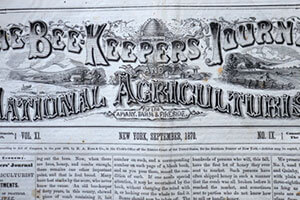
As Spring draws near, beekeepers begin to anticipate the honey season. The same was true in 1870. Beekeepers of the past wished, planned, and prayed for a bountiful season. While we share the same sentiments, their beekeeping conditions were vastly different from ours today. Movable frames were still spreading across the country, displacing fixed-comb hives. Beekeepers debated the merits of the new fangled honey extractor. Detractors ardently predicted its ultimate demise.
Old apicultural periodicals can reveal rarely seen beekeeping conditions. In the history of American apiculture, about one hundred beekeeping periodicals began. Virtually all failed. The American Bee Journal, starting in 1861, and Bee Culture starting in 1873, are the two oldest survivors. Nevertheless the obscure ephemeral ones, in their brief blooms, give glimpses of beekeeping long gone, yet still with common connections to current beekeepers.
Today beekeepers prepare their supers for the Spring nectar flow, but what if supers had not yet evolved? In the 1880’s, comb honey sections were in their golden age of glory, but what about before J. S. Harbison made them popular? Today beekeepers clean up their bee smokers to be ready for the season ahead, but what if Moses Quinby had not yet invented the bee smoker (in 1873)?
Not knowing the future held these valuable implements, a beekeeper running what we would call a commercial operation still planned to send some 10,000 or 20,000 pounds of honey to market in 1870, or even before. That is where additional beekeeping periodicals contributed more voices by describing their conditions and pictures, as wood cut engravings, which were expensive to produce.
One of these beekeeping periodicals was in a short newspaper format. I collect these old beekeeping periodicals and figure the newspaper ones had an added survival disadvantage. As a wad of paper, they were more prone to start a fire in a wood stove in the early 1870’s, and more likely to be consigned to the flames than a journal format, which had the connotation of a valuable book.
The Bee-Keepers Journal and National Agriculturist for the Apiary, Farm and Fireside was published by H. A. King & Company from New York, N. Y. I am working from the September 1870 issue (see Figures 1 and 2), which showed the results of the honey production season, after all the planning, swarming, and worrying about the weather. As we will see, their honey crop looked very different from today’s.
In the section of the paper where the publisher encouraged “Bee-keepers Write For Your Paper,” one author known only by H. A. K. (which is probably H. A. King himself) noted the recent spread of the movable comb (which was made public in 1852) made the honey trade become vastly important. He recognized beekeepers could “make more money with less capital or labor by bee-keeping than most large fertile farms.” He went on to state that some beekeepers realized the benefits by “owning but a few acres of land, with light taxes, as their stock finds their own pasturage for ‘roam as they will, the whole region is their common.’”
(Common referred to common pastureland where one had the right to graze animals on particular land tracts, along with others, by previous traditional arrangements or communal land ownership. By the author’s thinking, anywhere a bee found a flower became common pasture.)
While a progressive beekeeper would have redesigned the hive to accept movable frames based on the …


